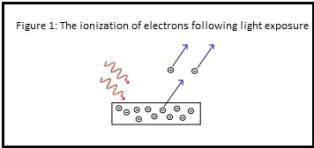
Background
The progression of low-level laser therapy as a viable therapy has made tremendous strides since the early investigations conducted nearly a century ago to assess how light can affect atom bound electrons. The photoelectric effect, a theory postulated by Max Plank and later proven by Albert Einstein in the early 1900s, identified that light was quantized and carried the force for the electromagnetic field, acting both as a wave and particle.
It was described by Einstein that light of a particular energy or color, as described by the following equation (Energy = plank’s constant x speed of light/wavelength), is capable of inducing electron emission at higher frequencies (lower wavelength) and independent of the intensity of light, an occurrence known as ionization (Fig. 1).

Einstein revealed that no matter how high the intensity was increased, if the photon did not possess a specific energy (frequency), the electron could not be ionized. Adjusting to the wavelength capable of ionization and increasing the intensity did, however, promote a greater number of photonic collisions with the atoms thus escalating the number of electrons emitted from the atom. This simple concept of increasing the intensity to obtain enhanced photoreactivity however does not translate well when applied to the human model.
It has been more than 100 years since Einstein stimulated metal surfaces to demonstrate the photoelectric effect and since that time research has demonstrated that electrons when stimulated with the correct wavelength can become excited, leaving the ground state and entering an excited state, becoming more bio-reactive as electrons can temporarily reside on the outer orbital of an atom.
A key word in the previous sentence is “temporarily,” as I am reminded of the phrase “what goes up, must come down”; and in fact, the electron must return to a ground state, and in doing so, energy is released.
The release of energy can result in transient heating of the photoabsorbing molecules within nonphotosynthetic cells, and too much electron excitation induces large quantities of heat release. Identified photoabsorbing complexes are simple proteins that possess prosthetic metal groups forming chromophore structures, and like all other proteins, function under ideal parameters regarding temperature and pH is essential. Increasing the intensity may sound like a clever means to enhance photobiomodulation of cells, but recent clinical trials have demonstrated the opposite.
Research
A recent paper “Biphasic Dose Response in Low Level Light Therapy” co-authored by Dr. Michael Hamblin, Professor at Harvard Medical School, was published in the journal Dosage in 2009.1 Dr. Hamblin and colleagues discussed the dogma of intensity and dosage as they apply to laser therapy.
The authors assessed numerous clinical investigations and concluded that the delivery of lower intensity across greater treatment times yielded higher utility.1 Dr. Hamblin et al. postulated that higher intensity devices generate a detrimental level of reactive oxygen species (ROS) limiting the benefit of laser therapy and perhaps transforming this modality into a harmful therapy.1
The concept proposed by Einstein a century ago precludes the complexity of the human cell and the fragile homeostasis that must be maintained in order to preserve cell function and viability.
Increasing the concentration of photons to a selection of tissue can actually be achieved without increasing the intensity, and this concept has been best demonstrated by the Erchonia handheld device. Employing a distinctive line-generated beam, the Erchonia handheld device is able to deliver an extraordinary concentration of photons across a vast surface area, upholding the basic principles proven by Einstein while understanding the complexity of the human cell. In addition to the unique means in which the photons are emitted, the Erchonia handheld device delivers 635 nm light at low-intensities, a therapeutic approach that is proven to be clinically ideal.
Speculation regarding the efficacy of the Erchonia handheld device is not necessary as it has been used in more than six placebo-controlled, randomized, double-blind, multicentered clinical investigations. Each clinical trial was able to accurately illustrate the efficacy of this modality and importance of delivering light at lower intensities with greater treatment durations.
Conclusions
Applying light therapy seems like a basic concept, aim and treat, but this technology is intertwined with complex subtleties that require understanding to ensure the best possible therapy is utilized. Wavelength, intensity, and dosage are all complex parameters of low-level laser therapy, and determining the best combination can be a tiresome and defeating process.
The market has become saturated with devices avoiding appropriate clinical testing. Laser therapy although innocent and harmless in principle can be dangerous when the intensity is increased, and that is why this therapy must adhere to evidence based medicine, proving a claim through a Level 1 clinical study.
The Erchonia handheld has embraced the philosophy that lower is better, and it is only recently that the medical community is demonstrating through thorough clinical data that both Einstein and Erchonia are right. To quote Dr. Hamblin, “Low levels of light are good for you while high levels are bad for you.”
References
1Ying-Ying H, et al. Biphasic dose response in low level light therapy. Dose-response 2009;7:358-383.
This research was provided by Erchonia Medical Inc.
888-242-0571 * www.Erchonia.com
